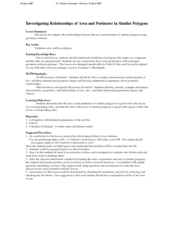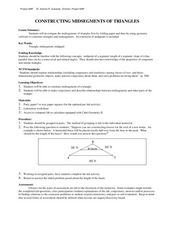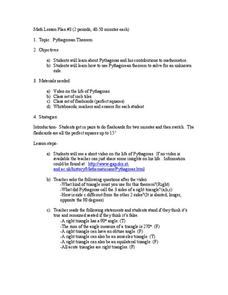Curated OER
Investigating Pythagorean Triples
Students investigate and solve Pythagorean triples. In this geometry lesson, students find the missing sides and angles of a right triangle. They graph right triangles and move the sides around to create different angles.
Curated OER
Why can't We Use SSA to Prove Triangles Congruent?
Pupils investigate triangles and congruences. In this geometry lesson, students differentiate between inductive and deductive reasoning. They differentiate between similar and congruent triangles.
Curated OER
Circumscribed Polygons
Students investigate polygons and construct ferris wheels. In this geometry lesson, students create a circle and differentiate properties of circles and polygons. They compare the relationship between angles and circumscribed polygons.
Curated OER
Investigating Trigonometric Ratios Through Similar Right Triangles.
49Students investigate the properties of right triangles. For this geometry lesson, students differentiate between similar and congruent triangles. They use the Pythagorean Theorem to find the missing angles and sides.
Curated OER
Investigating Trigonometric Ratios Through Similar Right Triangles
Pupils identify similar and congruent right triangles. In this geometry lesson, students use trigonometric ratios to identify missing sides and angles of a triangle. They differentiate similar and congruent triangles.
Curated OER
Tessellations
Students create tessellations. In this geometry lesson, students use polygons to create different patterns by rotation. They identify the reasons for polygons to create the type of tessellation it does.
Curated OER
Investigating the Pythagorean Triples
Students investigate the Pythagorean triples. In this geometry lesson, students solve for different parts of a right triangle. They identify the missing side or angle using the pythagorean theorem.
Curated OER
Inscribed Quadrilaterals and Parallelograms
Students differentiate between inscribed quadrilaterals and parallelograms. In this geometry lesson, students identify the shaped of the polygons when it is inscribed inside of a circle. They calculate the missing angles of the inscribed...
Curated OER
Exploring the Hinge Theorem
Students explore the application of Hinge Theorem. In this geometry lesson plan, students write inequalities, given two sides of a triangle. They solve problems with triangular inequalities using the proper theorem.
Curated OER
Dividing Line Segments into n Congruent Parts
Pupils identify lines, and line segments. In this geometry lesson, students divide line segments into equal congruent parts. They complete a laboratory activity dealing with lines and segments.
Curated OER
Investigating Area and Perimeter of Polygons.
Student sinvestigate the area and perimeter of polygons. They differentiate between similar and congruent polygons.. They identify the ratio and proportions of the sides and angles of polygons.
Curated OER
Pedal Triangles
Students identify the properties and theorems of triangles. In this geometry lesson, students construct angle bisectors using a compass and straight edge. They identify triangular similarity and congruency.
Curated OER
Constructing Midsegments of Triangles
Students construct midsegments. In this geometry lesson plan, students make conjectures and apply properties of triangles to solve problems. They complete an activity on the computer.
Curated OER
The Minimal Distance Point from the Vertices of a Triangle
Students calculate the distance from the vertex of a triangle to the center. In this geometry lesson, students find the shortest distance between a point and the vertex of a triangle. They relate this concept of distance to the real world.
Curated OER
Areas of Polygons
Pupils calculate the are of regular polygons. In this geometry lesson, students create polygons on the computer and move it around to create different shapes. They explore the area of different polygons and how they inter-relate.
EngageNY
Informal Proof of AA Criterion for Similarity
What does it take to show two triangles are similar? The 11th segment in a series of 16 introduces the AA Criterion for Similarity. A discussion provides an informal proof of the theorem. Exercises and problems require scholars to apply...
K12 Reader
Geometric Shape Names
Combine math and language arts in the same lesson with a reading passage about number prefixes in geometric shapes. After reading several short paragraphs about the different prefixes used in shape names, kids answer five comprehension...
Curated OER
Congruence in Triangles
In this geometry worksheet, students identify and label triangles as being congruent or not. They use the SSS, ASA or SAS as their description. There are 18 questions with an answer key.
Curated OER
The Flat Earth
Students differentiate between different planes. In this geometry lesson plan, students differentiate between a plane and a sphere. They discuss the Great Circle, Geodesic and Lune as it relates to the earth.
Curated OER
Drawing Quadrilaterals
In this math worksheet, learners draw quadrilaterals and also find the sums of the inner angles for each. They practice drawing rhombuses as unique quadrilaterals.
Curated OER
Triangle Attributes and Measures
Seventh graders explore the concept of triangles. In this triangles activity, 7th graders sort triangles according to various attributes such as acute, obtuse, isosceles, or equilateral. Students find the area and perimeter of triangles.
Curated OER
Surface Area with Polydrons
Students explore measurements by analyzing geometric shapes. In this surface area lesson, students identify the terms volume, weight, perimeter and area in order to find the requested measurements of specific polygons. Students utilize...
Curated OER
Pythagorean Theorem
Students explore the history of Pythagoras and his contributions to mathematics. In this middle school geometry lesson, students use one inch tiles to investigate the Pythagorean Theorem and to find the length of the sides of a right...
Curated OER
Math is Beautiful
Students explore how geometry is used on the composition of artworks by artists from different cultures. This activity is equally suited for a Math or Art classroom at the late-elementary or early-middle school level.























